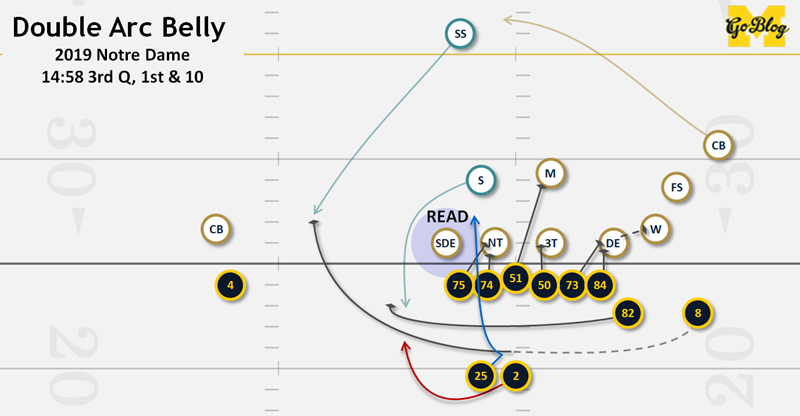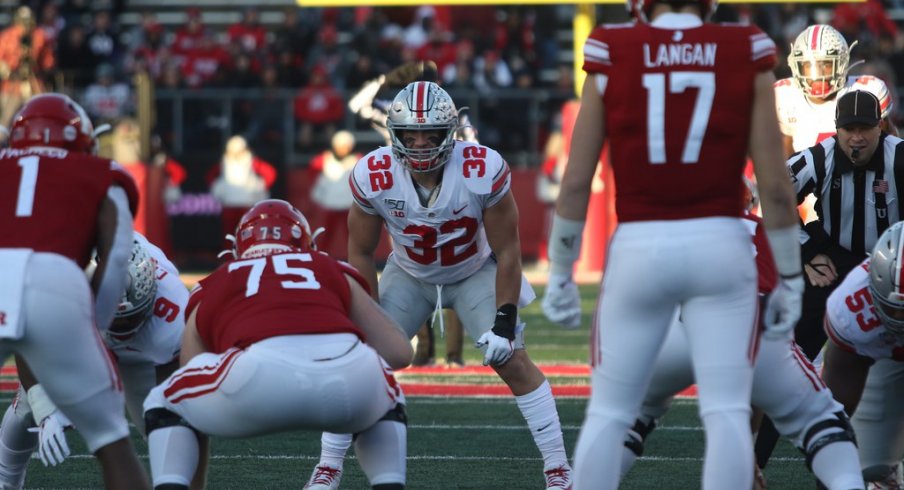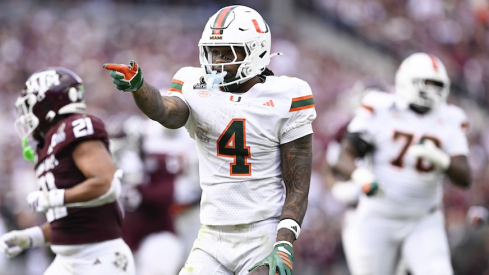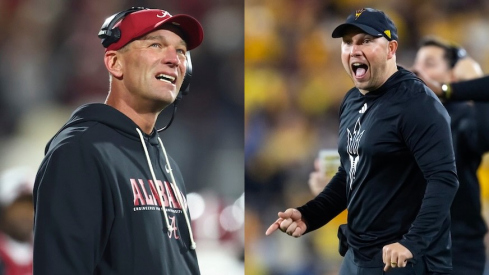Only nine times this fall has an Ohio State opponent rushed for 20 yards or more on a single play.
Compared to one year ago, this is a staggering change. In 2018, the Buckeyes surrendered 23 such runs in 14 games, showing a marked improvement in a category which largely forced the ouster of 4 defensive assistants last winter.
Despite entering the game as a massive underdog, Rutgers found a relative amount of success on the ground against the first-team OSU defense. While the Scarlet Knights were mostly toothless through the air, they were able to break off a few chunk plays thanks to a run game that schematically resembled the one seen in Columbus over the past half-decade.
With its season already lost, the Knights have turned to redshirt freshman Johnny Langan at quarterback in hopes of getting the athletic 6'3" 232-pounder valuable game experience. In eight games this season, Langan has carried the ball 101 times, picking up a first down 23 times with the capability of breaking big plays.
While other teams on the Buckeye schedule have featured quarterbacks capable of posing a real threat to move the ball with their feet, few made that tactic a core piece of their game plans against the Silver Bullets. Yet Langan was able to find a seam to pick up a 21-yard first-quarter gain thanks to an option play in which he was the primary ball-carrier.
The Scarlet Knights followed the rules set forth by Urban Meyer, who was fanatical about his desire to gain a numerical advantage in the running game by including the quarterback. The Knights showed a variety of option looks, leaving an athletic Buckeye defender unblocked and using their movements against them.
For the first time this season, however, an opposing offense was able to leverage the Buckeyes' base Cover 3 look against them, gaining an extra body in the box knowing free safety Jordan Fuller wouldn't leave his spot in centerfield.
Though the Buckeyes employ a variety of man, zone, and blitz schemes from this look, they've hardly deviated from this single-high safety look. Even when employing a 4-4 look that should be stout against the run, it's incumbent upon the outside linebackers to set the edges, turning any runs back inside toward their teammates while the cornerbacks bail to their deep-third zones outside.
When the outside 'backer doesn't keep proper leverage on a run and funnel plays back inside, the last resort is a cornerback reading the play and flying upfield to make a tackle. Luckily for Ohio State, freak athletes like Shaun Wade are in this spot (bumping outside from his typical slot-corner position due to Damon Arnette's wrist injury) and are capable of neutralizing potential big plays.
This type of attack is one major reason single-high defense fell out of favor roughly a decade ago. As Spread offenses became the norm and virtually every team in America began running some version of the zone-read, defenses were forced to deviate from a system that had been the preferred method of stopping the run for nearly three decades.
Over time, high school and college defenses began sniffing out ways to slow down these shotgun running games (the NFL is a different story), through the use of both scheme and technique. Two-high Quarters systems like the one made famous by Mark Dantonio and Pat Narduzzi at Michigan State allowed the defense to get nine players in the box, while other teams relied on simple means like the scrape-exchange, in which the defensive end and linebacker trade gaps to give the quarterback a false read.
As modern option football has evolved to include more passes (a.k.a. RPOs), single-high systems have come back into favor. The simplest answer to slowing RPOs has been man-coverage from a single-high set, but Alabama's hybrid Rip/Liz Cover-3 is the gold standard among defensive coaches in this regard. With the Buckeyes' ability to get three NFL-caliber cornerbacks on the field at once, it allows them to employ a similar system that keeps the eyes of all three linebackers in the backfield at once.
While the system installed by Greg Mattison and Jeff Hafley has proven dominant, sitting atop the nation in total defense, scoring defense, and pass defense, Rutgers showed (briefly) that there may be some vulnerable seams in the scheme. Of course, the OSU defense was without its best player, Chase Young, along with fellow starting end Jonathon Cooper, leaving less-experienced players at both spots. The Knights consistently put these players in conflict, hoping they'd make a mistake allowing for a big gain.
To do so, Rutgers routinely lined up in 3x1 formations that forced the Buckeyes to match with all three corners to one side, leaving an outside linebacker with the deep-third responsibility in zone coverage the opposite way.
Instead of leaving the tight end in to try and block the bigger defensive end, Zach Harrison, Rutgers appeared to release him on an arrow route to the flat as if he were going out for a pass. To help the outside linebacker who is effectively left on an island against this tight end in pass coverage, Harrison ensures he chips the supposed receiver but leaves a huge run gap open in the process.
The tight end essentially takes two defenders out of the play and forces Fuller to come down and make an open-field tackle. Plays like these were surely what senior defensive tackle Davon Hamilton meant when asked of his unit's performance following the game.
"I thought it was decent," Hamilton said. "But obviously we have some stuff to clean up."
Perhaps Hamilton was being too humble about the work he and his fellow tackles did to prevent even more big runs that day. As noted, the Knights constantly used formation and personnel to put more bodies in the box than there were defenders.
But instead of finding open running lanes, the Knights often ran into the waiting arms of unblocked Buckeye linebackers. Tuf Borland, Malik Harrison, and Pete Werner combined for 16 tackles in just two quarters, while Hamilton, Robert Landers, Jashon Cornell, and others forced double-team blocks that allowed those linebackers to run free to the ball.
Landers, in particular, had a big day, even though his name didn't even show up in the box score. The undersized nose tackle used his speed to shoot gaps and disrupt blocking schemes, allowing his teammates to clean up the play.
While stuffed runs like these were a constant sight against the overmatched Scarlet Knights, they may be harder to come by over the next two weeks when Ohio State's schedule gets much harder. Though the defensive line appears to be a strength for the Buckeyes, especially with Young's return, the unit as a whole can't plan on forcing a double-team or gaining penetration from the tackle positions every time.
Penn State's offense remains the same "Chipotle" system implemented by Joe Moorhead in 2016, which isn't complex but mixes a number of simple ingredients together through options. Though the Nittany Lions have leaned on creating big plays, generating 40-yard gains 17 times this fall (good for 14th nationally), they struggled to consistently run the ball effectively.
Though they have a stable of talented recruits in the backfield, it's quarterback Sean Clifford who is second on the team in rushing yards and is often called upon to run option schemes when PSU absolutely must pick up yards on the ground.
Additionally, Jim Harbaugh's latest experiment finally appears to be gaining traction. After well-documented early-season struggles, the offense in Ann Arbor has looked like the explosive unit many expected upon the hiring of coordinator Josh Gattis.
Though much of the fanfare has surrounded Shea Patterson and the passing game, which most recently amassed 384 yards against rival Michigan State last week, the turnaround has been keyed by the maize and blue rushing attack. Through the use of 12 personnel (much like Rutgers employed on some of their big runs), Gattis gashed Notre Dame's defense to the tune of 303 rushing yards last month.

As outlined by Seth of MGoBlog, the Wolverines employed a well-designed, option-based running game that can be adapted each week to attack the weakest points of a defense. Though Shea Patterson may not be Braxton Miller in the open field, he's certainly a capable runner, making this sound a lot like what Ed Warriner did with the Buckeye running game while coaching the offensive line in Columbus.
Not only will defenses use the option run game in an attempt to neutralize Young, attempting to read him instead of attempting to block him, but they'll look to out-flank the Buckeyes on the edges, expecting the Buckeye corners to bail from the line of scrimmage in zone coverage. As such, the most important Silver Bullets over the next two weeks may not be Young, the talented corners, or the reinvigorated linebackers, but rather, the rotation of interior linemen like Hamilton and Landers along the defensive line.
Winning the line of scrimmage may well be the key to finishing the regular season undefeated, something Ryan Day undoubtedly recognizes.
"Now all the focus -- the minute that game went to zero -- is on Penn State and getting ready for this next run," Day said Saturday night in New Jersey. "We gotta do everything we can to prepare for this game and it starts right now... We'll get home tonight, get some rest and then get back in there tomorrow, have a meeting and get right to Penn State."



